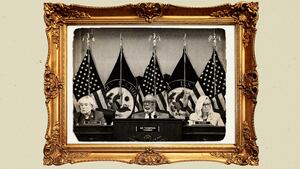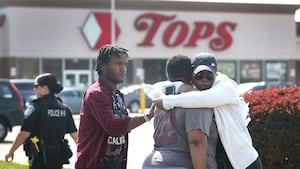With the Jan. 6 hearings underway, we’re getting new details on what unfolded behind the scenes during those crucial hours when the Capitol was under attack by a mob of Trump supporters. One of the lesser-noticed revelations of these hearings would have been, in any other context, a historic bombshell.
“Trump gave no order to deploy the National Guard that day, and made no effort to work with the Department of Justice to coordinate and deploy law enforcement assets,” according to Rep. Liz Cheney, the committee’s vice chair. “But Mike Pence did each of those things.”
That’s a remarkable claim, not just about former President Donald Trump’s dereliction of duty, which was already fairly apparent. It also shows that in the midst of a violent constitutional crisis, then-Vice President Mike Pence flatly usurped the president’s constitutional authority without following the proper procedures for doing so. And the rest of the government, including the military, appears to have gone along with it.
It pales in comparison to the other acts of violence done to the Constitution that day, as well as the underlying conspiracy to install Trump as an unelected autocrat, and the mob attack on Congress he incited. Still, what Pence did here shouldn’t be overlooked. And even with his extremely understandable motives in an extraordinary moment of crisis, we should carefully consider what he did and how he did it.
The president is the sole commander-in-chief of the armed forces. The vice president plays no such role and has no lawful authority to issue orders, either to the military or civilian agencies. Orders flow directly from the president to the secretary of defense to those in uniform. But the breakdown in the constitutional chain of command on Jan. 6 was not entirely unprecedented. We’ve had incapacitated presidents before, leaving aides and members of the Cabinet struggling to figure out what to do about it.
The problem is, we amended the Constitution to fix that. And Mike Pence refused to follow the terms of that amendment. While he was defending the Constitution, he failed to properly follow the one part of the Constitution tailor-made for this scenario.
Who’s In Charge Here?
The Constitution designates the vice president with two jobs. First, to preside over the Senate with a tie-breaking vote, and second, to serve as the presidential understudy, able to assume the top job if needed. As the Framers put it: “In Case of the Removal of the President from Office, or of his Death, Resignation, or Inability to discharge the Powers and Duties of the said Office, the Same shall devolve on the Vice President.”
That provision seemed simple enough. If the president dies or gets removed from office, the vice president becomes the new president. But what about that “inability” part? Who gets to decide that? What if the president insists he is able?
After he was shot in July 1881, James Garfield lingered for months until he finally died in September. During that time, he was bedridden and often in a state of delirium as infection ravaged his body. In 1901, another assassin shot William McKinley, who was on his deathbed for eight days before the presidency passed to Teddy Roosevelt. In 1919, Woodrow Wilson suffered a debilitating stroke that left him almost entirely secluded and with a tenuous grasp on reality for the remainder of his term.
In all three of these cases, the vice president made no effort to exercise his constitutional responsibility to fill in during cases of presidential inability. Instead, they felt compelled to resist the appearance of being hasty, eager, or even a usurper. So instead, the government muddled on in a state of limbo.
That’s where things stood in the early 20th century, but the world was changing. The federal government had already expanded considerably, and events on the world stage began to move faster with the advent of instantaneous communications. A president out of commission could have more immediate and urgent consequences, but there was still no clear way to handle it.
By the time the Cold War rolled around, the age of nuclear weapons made minute to minute control of the presidency a vital practical concern. Eisenhower was particularly aware of the problem, as he was repeatedly sidelined by heart attacks during his time in office. In secret, he and Vice President Nixon exchanged letters creating an informal system and approval for Nixon to assume power if Eisenhower was incapacitated.
In 1963, one last moment of tragedy finally spurred Congress to fix a problem nearly two centuries in the making. Struck by a sniper’s bullet, John F. Kennedy had died quickly, and Lyndon Johnson was sworn in just two hours later. But the possibility of what might have been did not go unnoticed. What if, instead of dying immediately from a fatal head wound, Kennedy had slipped into a coma? Who would have been in control of America’s nuclear arsenal? Ambiguity was no longer acceptable.
Congress Tries to Fix A Problem
Sen. Birch Bayh, a Democrat from Indiana who chaired the Subcommittee on Constitutional Amendments, had had enough. He crafted and in 1967 secured the passage of what became the Twenty-fifth Amendment, spelling out in great detail what to do when the commander-in-chief is out of action.
Section One of the amendment codified the precedent that in the event of a presidential vacancy, due to death or any other permanent reason, the vice president “shall become President.” Section Two allowed a way to fill vacancies in the vice presidency, ending the practice of simply letting it go vacant until after the next presidential election. Section Three allowed the president to voluntarily transfer power to the vice president, until such time as the president chooses to resume his responsibilities. Lastly, Section Four allowed the vice president, together with a majority of the Cabinet, to declare the president “unable to discharge the powers and duties of his office,” putting the vice president in charge.
Bayh and the other authors of the new amendment didn’t attempt to define “unable.” They knew it would be impossible to predict all the possible circumstances which could arise. Instead, they laid out a procedure for who can decide. The vice president now can obtain the legal blessing of the Cabinet, the president’s own closest appointees, to legitimately take power. If there is any dispute over the matter, it would go to Congress to decide under an expedited procedure.
Understandable, but Wrong
If he had directly requested it on Jan. 6, Pence could have had approval from a majority of the Cabinet within the hour. We know at least a couple of Cabinet members—Education Secretary Betsy DeVos and Transportation Secretary Elaine Chao—resigned in part because Pence refused to formally invoke the 25th Amendment. Others, including Secretary of State Mike Pompeo, reportedly discussed it.
The House of Representatives later passed a resolution calling on Pence to invoke the 25th. It was a dubious exercise, since the House should have moved straight to using its own power of impeachment. But Pence’s response offers us some insight into his reasoning. “Under our Constitution,” he wrote, “the 25th Amendment is not a means of punishment or usurpation.” And that’s entirely right.
But Pence’s own actions indicate the 25th Amendment’s standard was met, at least as he saw it. Faced with a president who was clearly unable to carry out his responsibilities, Pence exercised those powers himself. His actions amount to invoking the 25th Amendment in practice but not in name, with none of the legitimacy and transparency the amendment was intended to create.
As understandable as his motives were, Pence’s actions should be repudiated as a precedent. The next time a vice president feels that the president is incapacitated, power should be transferred the right way, following the part of the Constitution written for that purpose. No matter how uncomfortable the political optics, the vice president’s first obligation is to follow the Constitution. Pence did that when it came to presiding over the electoral count in Congress, and he should have done it when dealing with a president deliriously out of touch with reality.









